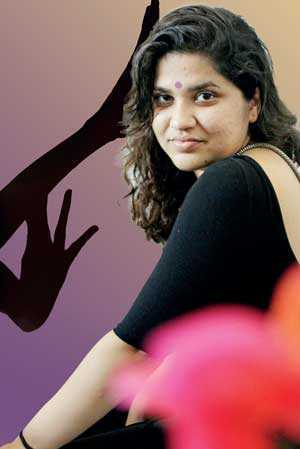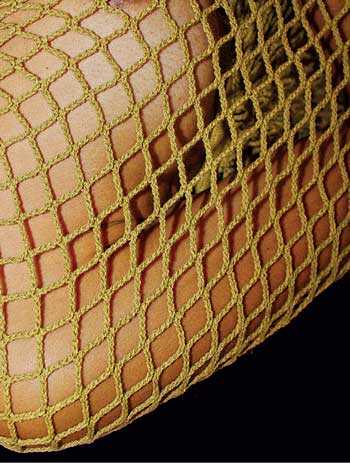Tuesday Jan 13, 2026
Tuesday Jan 13, 2026
Saturday, 31 August 2019 00:10 - - {{hitsCtrl.values.hits}}
The Watch List shines the spotlight on artist Minal Wickrematunge, as she prepares to launch her first solo exhibition next weekend, 7-8 September, at the Lionel Wendt Art Gallery. Titled ‘Sensuous,’ Minal hopes the exhibition pieces generate conversations around a topic that is taboo. “Sensuality is a fascinating topic in the Sri Lankan context, because it is taboo. Women are ashamed to explore these notions as there is an emphasis on purity and innocence in our society,” she explained, adding that she wants to expand people’s perceptions around what the word means in the Sri Lankan and South Asian context. Following is the interview:
Q: You’re currently preparing for your debut solo exhibition titled ‘Sensuous,’ which invites viewers to ‘explore all the connotations of sensuality’. What can we expect?
This exhibition is an exploration of the notion of sensuality and what it means. The term itself evokes certain images. I want to expand people’s perceptions around what the word means in the Sri Lankan and even South Asian context. I’m using several different mediums for this exhibition, from collages to paintings. 
Q: How long did it take to put the exhibition together and why did you select this theme?
It took around two months of rigorous work. I really wanted to make sure that there was a clear theme and a flow to the pieces I chose. I had many different ideas I wanted to explore, but ended up dropping a few to make sure what I had in mind was conveyed clearly.
For me, the act of creating art can become all-encompassing – my mind will become fully occupied with trying to interpret the ideas I have in my head and bring them to life. So there have been more than a few sleepless nights, and it has been pretty much my sole focus for the past few months.
In a sense though, you could say I have been working towards this for much longer than two months. Sensuality is a theme I have been exploring in my work for around three years now. I find it a fascinating topic in the Sri Lankan context, because it is taboo. Women are ashamed to explore these notions as there is an emphasis on purity and innocence in our society.
Q: You describe the word sensuality as one that ‘evokes images which are simultaneously pleasing and discomforting in a traditional South Asian society’. What is the message you hope to convey with the images being showcased?
I don’t want to prescribe a message to the work. Art is subjective and people may take away different messages from the pieces. My aim is to pose questions visually, for people to come to their own conclusions and, hopefully, question some of their perceptions around sensuality.
Q: What kind of a reaction are you hoping for from the local audience? What is the message you hope they will take away from this exhibition?
It’s no secret that this subject is taboo in Sri Lanka. In that sense, some of the pieces may make people uncomfortable. This ‘confrontation’ is something that I have explored in earlier work. In a way, I am trying to question societal norms and definitions around sensuality. The location of the exhibition is I think fitting. On the walls at the Lionel Wendt are some pieces from his series of nude photographs. Almost a hundred years later, photographs of nudity still evoke similar reactions. In a sense, I’m trying to understand why.
Q: When you say ‘women are surveilled’ and ‘some try to circumvent this surveillance through expression online, but what is freeing can also alienate,’ what does this mean in terms of your own experiences and how can women meet these challenges?
As a woman you are aware that there are eyes always on you, even when you are just walking down the street. I would say this applies not just to women but to anyone who is seen as slightly different according to our societal and cultural norms or who defies the roles society dictates we must conform to. Some people feel the pressure to conform so as to ‘fit in’. Others are finding ways to express themselves.
With the advent of social media, people now have a platform to express themselves online. From Instagram to Twitter to Facebook and even TikTok, people showcase certain parts of their personality online that they might hide or be less confident in expressing in real time.
At the same time, it has to be asked whether this is a sign of progression, or yet another barrier to authentic self-expression. Are we curating perfect profiles? Is what we see online our personality, or our personal brand? I tackle this question specifically in some of the pieces I chose for the exhibition.
Q: In describing your exhibition, you ask the question, ‘What does connection mean in a world where the line between the digital and the physical is blurred?’ What does it mean to you?
Too often, the first thing we do when we wake up is scroll through our timelines. The interactions we have online have become part of our daily life, so much so that it is no longer clear that the two are separate. Comments made online can impact us offline.
At the same time, the dopamine rush we get from a ‘Like’ or a ‘Share’ is a new phenomenon in a world that used to value physical connection. Eye contact, the sound of the other’s voice, facial expressions and bodily expressions are so important in forging connections in my opinion – and I’m trying to discover whether this has been replaced by online interactions.
 Q: Do you use your art to showcase and fight for what you believe in and what kind of change do you hope to bring about through art?
Q: Do you use your art to showcase and fight for what you believe in and what kind of change do you hope to bring about through art?
I hope so! I wouldn’t term it a fight as much as me trying to have a conversation using art.
I’m more wary of words; I think there’s great power in images. The arts are so important in influencing social change, or in spurring on movements particularly in topics that aren’t widely or openly discussed.
Apart from this, creating art is for me extremely therapeutic. Sometimes I create to help make sense of confusing and upsetting experiences and circumstances in life. So if I can inspire someone else to express themselves through art, I’d be happy with achieving that. I also hope that the pieces generate conversations around a topic that is taboo.
Q: When and how did you venture into art and how has the journey been?
I have been drawing since childhood. During my Ordinary Level examinations I didn’t study art, but I painted to help de-stress during study breaks. This habit stuck with me all the way until I was studying Business Management in college and even when I worked at a large corporate. I only really focused on my art seriously when I joined Academy of Design and had to use my skills for my projects and work as an interior designer.
Q: What are the key causes you focus on via your creations?
Sensuality is a topic I’ve long worked on, and will continue to work on beyond this exhibition. Other themes that I’ve explored include identity and language – this was the key focus of my final year project at the Academy of Design. I’ve also tackled more political topics such as freedom of expression, violence and brutality through my collages in the past.
Q: What inspires you?
I think my main source of inspiration right now is looking at the strong women around me. Apart from that, nature, poetry, music and people who have endured great losses or tragedies and yet find a way to persevere are so inspiring to me.